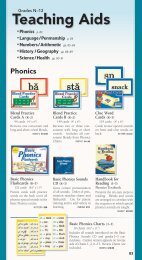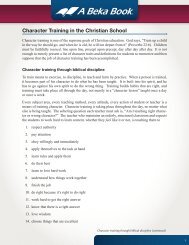Science & Health - A Beka Book
Science & Health - A Beka Book
Science & Health - A Beka Book
You also want an ePaper? Increase the reach of your titles
YUMPU automatically turns print PDFs into web optimized ePapers that Google loves.
Physics cont.<br />
Laws of Thermodynamics—Internal Energy cont.<br />
• Thermodynamics<br />
h Internal energy equation<br />
h Qualitative explanation of adiabatic processes, isothermal<br />
• Ideal gas law:<br />
h Reversible and irreversible processes<br />
• Second Law of Thermodynamics:<br />
• Entropy:<br />
h Quantitative definition<br />
• Tendency to minimum energy and maximum entropy<br />
h Other formulations of the second law<br />
h Cause of ordered complexity<br />
h Evolution and the second law of thermodynamics: evolution’s<br />
challenge to science<br />
h Zeroth and Third Laws of Thermodynamics: thermal equilibrium<br />
Waves<br />
• Transverse waves:<br />
• Wave pulse, crest trough<br />
h Elastic medium<br />
• Energy transport<br />
• Wave properties:<br />
h Simple harmonic motion, sinusoidal, periodic<br />
• Frequency, period, speed, wavelength, amplitude<br />
h Wave classification:<br />
h One-, two-, and three-dimensional waves<br />
h Interface, wavefront, ray; straight, spherical, and plane waves<br />
• Longitudinal waves:<br />
• Compression pulse, rarefaction pulse, longitudinal waves<br />
h Sinusoidal character of longitudinal waves<br />
• Water waves, sound waves<br />
• Boundary effects:<br />
• Reflection:<br />
• Angle of incidence, angle of reflection, law of reflection, reflection<br />
of sound, sonar<br />
• Refraction: of sound waves<br />
• Diffraction: of sound waves<br />
• Superposition:<br />
h Composite wave trains<br />
• Constructive and destructive interference<br />
h Standing wave train, standing wave:<br />
h Node, antinode, loop, envelope of oscillation<br />
Sound<br />
• Nature of sound:<br />
h Graphical representation of sound waves:<br />
h Displacement and pressure wave trains<br />
• Speed of sound:<br />
h Hardness<br />
• Density, temperature, effect of air temperature<br />
• Doppler effect:<br />
h General Doppler equation<br />
• Sonic booms, supersonic speed, shock wave<br />
• Characteristics of sound:<br />
• Intensity:<br />
h Threshold of hearing, quantitative treatment, amplifying<br />
<strong>Science</strong><br />
186<br />
Grade 12<br />
h red indicates NeW MATerIAL<br />
• Loudness:<br />
h Nonlinear receiver, relative intensity, quantitative treatment<br />
• Decibel<br />
• Pitch:<br />
h Sonic spectrum, mean free path, audio spectrum<br />
• Infrasonic and ultrasonic waves<br />
h Cavitation<br />
h Ear’s nonlinear response to frequency<br />
Nature of Light<br />
• Early light theories:<br />
h Ancient contributions, camera obscura, rectilinear propagation<br />
• Huygens’ theory<br />
• Newton’s theory:<br />
h Corpuscles<br />
h Young’s demonstration, Herschel’s discovery<br />
• Infrared rays<br />
• Maxwell’s theory, electromagnetic waves, photons, wave-particle<br />
duality<br />
• Electromagnetic spectrum:<br />
• Nature of an electromagnetic wave: range of wavelengths, electromagnetic<br />
spectrum, Planck’s constant<br />
• Regions within the electromagnetic spectrum: visible light, infrared,<br />
ultraviolet<br />
• Color:<br />
• Spectrum of visible light:<br />
• ROY G. BV<br />
h Solar spectrum<br />
• Monochromatic, composite light<br />
• Light mixing:<br />
• Additive mixing, primary colors<br />
h Secondary and complementary colors<br />
• Objects’ colors:<br />
• Surface color<br />
h Transparent, translucent, opaque, color filters, hue, pure color,<br />
brightness<br />
• Pigment mixing:<br />
• Subtractive mixing, subtractive primaries<br />
h Subtractive secondaries<br />
Reflection of Light<br />
• Laws of reflection:<br />
h Absorbed, scattered, transmitted, reflected, reflectance, specular<br />
and diffuse reflection<br />
• First law of reflection<br />
h Second law of reflection<br />
h Mirror images:<br />
h Plane mirrors: virtual and real images, right-angled mirror, double<br />
mirror<br />
h Concave mirrors:<br />
h Spherical mirrors, concave, convex, vertex, center of curvature,<br />
principal axis<br />
h Secondary axis, radius of curvature, aperture, point source<br />
h Focal point, focal length, focal plane, ray diagram<br />
h Principal rays: central, parallel, and focal rays; real and virtual image<br />
h Convex mirrors: spherical aberration<br />
h Parabolic mirrors<br />
Physics cont. p. 187

















